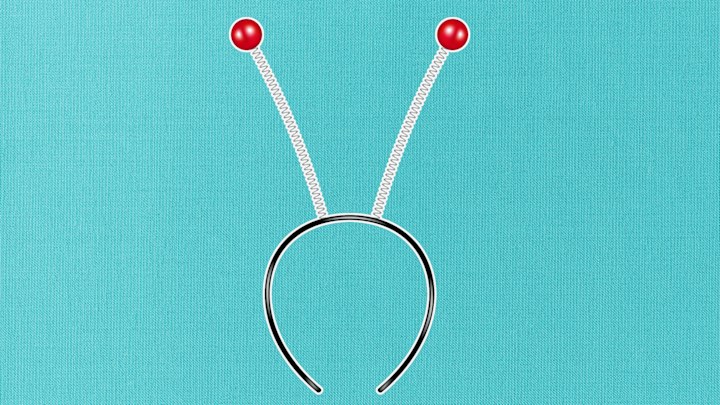When it comes to fads, the sillier, the better. The Pet Rock craze of the ‘70s convinced millions they needed an ordinary rock to care for; the edible underwear phenomenon during the same decade made a snack out of undergarments.
But few gag gifts broadcasted their nonsense better than Deely Bobbers, the headband-mounted antennae that briefly swept the country in the early 1980s and turned millions of people into impromptu insects. Fittingly, the Bobbers began with a man who had once struck gold making fun of the Ayatollah Khomeini.
Bobbers for Dollars

Stephen Askin always had a knack for irreverent novelty items. A one-time stockbroker and graduate of San Jose State, Askin’s company, What’s New, specialized in developing and marketing the kinds of things one might find in Spencer Gifts or in the back of a 1960s comic book. Those oversized foam cowboy hats? Askin was involved. Pac-Man pillows? Askin. An understuffed plush cat dubbed the Flat Cat? Askin again. At the height of the Iranian Revolution, he even marketed an Ayatollah Khomeini dartboard. (Khomeini, the leader of the Revolution, was not on friendly terms with the United States.)
At the risk of stating the obvious, Askin told People that “I’m not interested in overly tasteful American crafts.”
For the Bobbers, Askin was inspired by Saturday Night Live—specifically, the bee costumes and accompanying antennae worn by John Belushi and others during the insect-centric sketches of the late 1970s.
In 1981, Askin pursued the idea as a form of “kinetic sculpture,” with a headband (or tiara) sporting springs, glitter, and an eye-catching shape at the end. He decided to evaluate their appeal at the 1981 California Gift Show as well as the Los Angeles Street Fair, where he sold 800 of the Bobbers at $5 each.
Clearly, there was a demand for a novelty purchase that, in Askin’s words, “changes [people's] personalities instantly.” Askin began selling them to Spencer Gifts, Bloomingdale’s, and to Six Flags amusement parks. Demand for the Bobbers grew so large that Askin entered into a deal with the Ace Novelty Co. in Bellevue, Washington, to mass-produce them. Ace, in turn, trialed them in Seattle, where 30,000 of the Bobbers sold out. They were a version of Mickey Mouse ears, signaling to passersby that the wearer wasn’t taking things too seriously.
Ahead of the Curve

Soon enough, there was a near-endless variety of Bobbers on the market. Some were star-shaped; others had pinwheels; some could glow in the dark; a few had tiny airplanes with propellers blowing in the breeze. The inevitable knock-offs came, too, undercutting Askin’s official version by selling for as little as $1.
Any way you sliced it, the Bobbers became ubiquitous. “They seem to be the most popular headgear since the Sony Walkman,” observed The New York Times. They were exceedingly popular at the World’s Fair in Knoxville, Tennessee, and at Mardi Gras, where revelry and slightly inebriated decision-making made the product more appealing. The Bobbers appeared at an anti-nuclear demonstration in New York. Some even wore multiple Bobbers at once. Sales in 1982 were projected to be in the neighborhood of $15 million.
For Ace vice-president John Minkove, the appeal was simple. “They've set a lot of people laughing,” he said. “They’re absolutely useless, unless they help to work off tension. Whatever the state of the economy, most people have a buck to spend on some fun.”
Askin envisioned a Deely Bobber industry, one where bats would spring up on the headgear for Halloween. He exported them to England and Japan. He anticipated licensing opportunities with Garfield or The Smurfs. The only thing that could slow the Bobbers, he said, would be the weather. Snow and rain were not conducive to the bobbing action of the tiara.
That, and time: The Deely Bobber craze slowed fairly quickly. Askin went on to other ventures, most recently consulting for MicroPuzzles, a series of low-piece-count puzzles packed in test tubes and meant to be solved in a reasonable amount of time. While Deely Bobbers and the various knock-offs are still readily available, they’re no longer highly sought after.
And if you’re looking for hidden meaning in the name Bobbers, don’t bother. While Minkove's wife's friend used to use the term to denote a random item, “it doesn’t mean anything,” Askin said.
